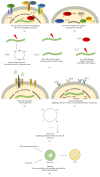Cancer Stem Cell Quiescence and Plasticity as Major Challenges in Cancer Therapy
- PMID: 27418931
- PMCID: PMC4932171
- DOI: 10.1155/2016/1740936
Cancer Stem Cell Quiescence and Plasticity as Major Challenges in Cancer Therapy
Abstract
Cells with stem-like properties, tumorigenic potential, and treatment-resistant phenotypes have been identified in many human malignancies. Based on the properties they share with nonneoplastic stem cells or their ability to initiate and propagate tumors in vivo, such cells were designated as cancer stem (stem-like) or tumor initiating/propagating cells. Owing to their implication in treatment resistance, cancer stem cells (CSCs) have been the subject of intense investigation in past years. Comprehension of CSCs' intrinsic properties and mechanisms they develop to survive and even enhance their aggressive phenotype within the hostile conditions of the tumor microenvironment has reoriented therapeutic strategies to fight cancer. This report provides selected examples of malignancies in which the presence of CSCs has been evidenced and briefly discusses methods to identify, isolate, and functionally characterize the CSC subpopulation of cancer cells. Relevant biological targets in CSCs, their link to treatment resistance, proposed targeting strategies, and limitations of these approaches are presented. Two major aspects of CSC physiopathology, namely, relative in vivo quiescence and plasticity in response to microenvironmental cues or treatment, are highlighted. Implications of these findings in the context of the development of new therapies are discussed.
Figures




Similar articles
-
Cell plasticity, senescence, and quiescence in cancer stem cells: Biological and therapeutic implications.Pharmacol Ther. 2022 Mar;231:107985. doi: 10.1016/j.pharmthera.2021.107985. Epub 2021 Sep 1. Pharmacol Ther. 2022. PMID: 34480963 Free PMC article. Review.
-
Evolving Strategies for Therapeutically Targeting Cancer Stem Cells.Adv Cancer Res. 2016;131:159-91. doi: 10.1016/bs.acr.2016.04.003. Epub 2016 Jun 3. Adv Cancer Res. 2016. PMID: 27451127 Review.
-
Cancer Stem Cells: Acquisition, Characteristics, Therapeutic Implications, Targeting Strategies and Future Prospects.Stem Cell Rev Rep. 2019 Jun;15(3):331-355. doi: 10.1007/s12015-019-09887-2. Stem Cell Rev Rep. 2019. PMID: 30993589 Review.
-
Cancer stem cell heterogeneity: origin and new perspectives on CSC targeting.BMB Rep. 2017 Mar;50(3):117-125. doi: 10.5483/bmbrep.2017.50.3.222. BMB Rep. 2017. PMID: 27998397 Free PMC article. Review.
-
Linking Tumor Microenvironment to Plasticity of Cancer Stem Cells: Mechanisms and Application in Cancer Therapy.Front Oncol. 2021 Jun 28;11:678333. doi: 10.3389/fonc.2021.678333. eCollection 2021. Front Oncol. 2021. PMID: 34262865 Free PMC article. Review.
Cited by
-
Quiescent stem cell marker genes in glioma gene networks are sufficient to distinguish between normal and glioblastoma (GBM) samples.Sci Rep. 2020 Jul 2;10(1):10937. doi: 10.1038/s41598-020-67753-5. Sci Rep. 2020. PMID: 32616845 Free PMC article.
-
Anti-GD2 antibody dinutuximab inhibits triple-negative breast tumor growth by targeting GD2+ breast cancer stem-like cells.J Immunother Cancer. 2021 Mar;9(3):e001197. doi: 10.1136/jitc-2020-001197. J Immunother Cancer. 2021. PMID: 33722905 Free PMC article.
-
Lipid metabolism dynamics in cancer stem cells: potential targets for cancers.Front Pharmacol. 2024 Jun 27;15:1367981. doi: 10.3389/fphar.2024.1367981. eCollection 2024. Front Pharmacol. 2024. PMID: 38994204 Free PMC article. Review.
-
Therapeutic Targeting of Cancer Stem Cells Prevents Resistance of Colorectal Cancer Cells to MEK Inhibition.ACS Pharmacol Transl Sci. 2022 Aug 25;5(9):724-734. doi: 10.1021/acsptsci.1c00257. eCollection 2022 Sep 9. ACS Pharmacol Transl Sci. 2022. PMID: 36110381 Free PMC article.
-
Exploiting oxidative phosphorylation to promote the stem and immunoevasive properties of pancreatic cancer stem cells.Nat Commun. 2020 Oct 16;11(1):5265. doi: 10.1038/s41467-020-18954-z. Nat Commun. 2020. PMID: 33067432 Free PMC article.
References
Publication types
LinkOut - more resources
Full Text Sources
Other Literature Sources
Miscellaneous

